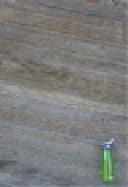Geoscience Reference
In-Depth Information
Fig. 6.28
Reservoir
modelling in thin beds:
a better approach, partly
decoupling the modelling
of porosity and
permeability modelling
Do logs
resolve
beds?
Not thin
yes
no
Are beds
net?
Staining
Exclude
no
yes
K from plugs or
mini-k
Data from
core?
yes
Ø from
plugs or
thin
section
no
Concepts &
scenarios
Model at fine bed
REV scale
Well tests
K
effective
Ø from
logs
Represent at
larger scale
Well tests
The heterolithic facies can be extensive, even
in high N/G systems, and in this example can be
traced along the cliff line for 4 km (Fig.
6.30
).
The impact of this architecture is illustrated in
2D sections through a 3D model (Fig.
6.31
), in
which the heterolithic intervals seen in Fig.
6.29
are included as discrete elements with
contrasting effective vertical permeabilities.
The effective vertical permeability in the
heterolithic units determines the sweep pattern.
In this case the heterogeneity improves recovery;
water breakthrough times increase from 3 months
to 3 years and recovery increases from 21 to 37 %
(after 16 years production) as the baffling effect
of the low-permeability interval holds back water
coning. The addition of higher permeability
channels within the sheet-like sands (the 'Jardin
de Roi' section in Fig.
6.31
) has the reverse effect
by provoking earlier water breakthrough. Both
the heterolithic facies and the channel facies are
likely to be sub-seismic, and these effects will be
missed by “seismic-only” workflows.
6.5.5 Summary
Despite huge advances in deep marine reservoir
developments, the experiences of the last decade
confirm that no matter how good the seismic data
is, there is typically essential sub-seismic hetero-
geneity in deep marine systems, especially in
fields to be developed under waterflood. Once
under production, 4D seismic is an invaluable
tool to help explain field behaviour, but by this


























